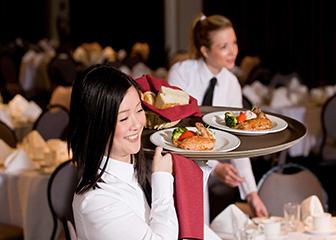Summary

| Quick Facts: Waiters and Waitresses | |
|---|---|
|
$18,330 per year
$8.81 per hour |
|
| Less than high school | |
| None | |
| Short-term on-the-job training | |
| 2,260,300 | |
| 9% (Slower than average) | |
| 195,900 | |
What Waiters and Waitresses Do
Waiters and waitresses take orders and serve food and beverages to customers in dining establishments.
Work Environment
Waiters and waitresses work in restaurants, bars, hotels, and other food service and drinking places. During busy dining hours, they are under pressure to serve customers quickly and efficiently. The majority work part time, including early mornings, late evenings, weekends, and holidays.
How to Become a Waiter or Waitress
Most waiter and waitress jobs are at the entry level, and workers learn through short-term on-the-job training. No formal education or previous work experience is required to enter the occupation.
Pay
The median hourly wage (including tips) of waiters and waitresses was $8.81 in May 2010.
Job Outlook
Employment of waiters and waitresses is expected to grow 9 percent from 2010 to 2020, slower than the average for all occupations. Job opportunities are expected to be very good because of the large size of the occupation and the many workers who leave their jobs each year. Those seeking employment at upscale restaurants will face strong competition.
Similar Occupations
Compare the job duties, education, job growth, and pay of waiters and waitresses with similar occupations.
O*NET
O*NET provides comprehensive information on key characteristics of workers and occupations.
Contacts for More Information
Learn more about waiters and waitresses by contacting these additional resources.








